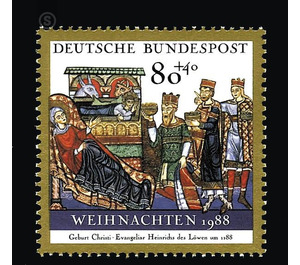Christmas - Germany / Federal Republic of Germany 1988 - 80 Pfennig
| Country | Germany / Federal Republic of Germany |
| Issue Date | 1988 |
| Face Value | 80.00 |
| Color | multi-colored brown |
| Perforation | K 13 3/4 |
| Printing Type | Six-color offset printing |
| Stamp Type | Postage stamp |
| Item Type | Stamp |
| Chronological Issue Number | 1269 |
| Chronological Chapter | GER-BRD |
| SID | 184241 |
| In 37 Wishlists | |
The Deutsche Bundespost publishes the Christmas stamps in favor of the Free Welfare. On 6 December 1983, the Federal Republic of Germany, the State of Lower Saxony, the Free State of Bavaria and the Prussian Cultural Heritage Foundation jointly acquired one of the most magnificent and valuable manuscripts of the Middle Ages at Sotheby's in London: the Gospel of Henry the Lion. The highest price ever paid for a single book has been raised for it: about DM 32.5 million. The Codex, an excellent testimony of medieval piety, is not only one of the great achievements of book art in Germany, but one of the most precious illuminated manuscripts that the Middle Ages ever left us. It was built in the Benedictine monastery Helmarshausen - today part of Karlshafen (Weser) - on behalf of Duke Henry the Lion and his wife Mathilde and was intended for the collegiate church of St. Blaise in Brunswick. Henry the Lion, the Welfe (1129/30 - August 6, 1195), son of Duke Henry the Proud of Bavaria and Gertrud of Saxony, the daughter of Emperor Lothar III, is considered one of the most important and powerful politicians of the Middle Ages. Emperor Frederick Barbarossa, first of all a friend of his, and then his victorious opponent, was his cousin. Henry's power finally threatened the position of the emperor. When he failed his army in great distress, it broke. In 1180, the Reichstag in Würzburg condemned his fiefs of Saxony and Bavaria, and in the same year the Duchy of Saxony was divided into Gelnhausen. The archbishop of Cologne received the western part as the new Duchy of Westphalia, Bernhard von Anhalt, son of Margrave Albrecht of the Bear of Brandenburg. eastern Saxony with the Duchy title. Heinrich kept only his own goods around Brunswick and Lüneburg and had to go into exile. It was not until 1190 and 1194 that peace was achieved. If Henry the Lion also failed in his quest for power in the Reich, but his cultural achievements were permanent, especially for Lower Saxony. His residence in Braunschweig was a center for art and literature, his foundations - the castle, the Lion Monument, the new building of the Blasiuskirche, the Gospel of Helmarshausen - continue to make his name stand out from the past. The Gospels associated with his name consists of 226 parchment leaves measuring 34.2 x 25.5 cm. In the beginning, a Latin dedicatory poem reports that for reasons of love for Christ, Heinrich and Mathilde - their royal, imperial descent - had the golden-glazed book made to offer it together with other gifts of Christ. They hoped for eternal life and for sharing in the community of God-justified people. The conclusion of the poem tells of the genesis of the book in Helmarshausen; it is called "Labor Herimanni". Herimann was a monk in Helmarshausen. The unusually rich and high-quality decoration of the book is divided into four groups: 1. 17 full-page canon panels; 2. 24 full-page miniatures; 3. 9 ornamental pages with the opening verses of the Gospels: 4. Decorations of the individual pages of the text. The miniatures and ornamental pages, which are the main decoration of the book, are preceded by the individual gospels as closed cycles: 6 miniatures and 3 decorative pages in front of Matthew, 5 miniatures and 2 ornamental pages in front of Mark, 6 miniatures and 2 ornamental pages in front of Luke, 7 miniatures and 2 Ornamental pages before John. Henry the Lion had ordered in 1173, soon after his return from a pilgrimage to the Holy Land, the construction of Blasiuskirche. The consecration and consecration of the church is reported for 1188 by the consecration of the Marian altar donated by the duke in the middle of the choir. Like the dedication poem, the text of the dedication emphasizes the imperial origin of Henry and the royal Mathildes. The Foundation of the Gospel will therefore be associated with the consecration of the Marian altar in time. It is therefore dated to 1188th Unknown and unknown way the Gospel got to Prague in the treasure of St. Vitus Cathedral. There it was rebounded in 1594 and received the present cover with relics on the front cover. The coat of arms of the founder of the binding, the Prague cathedral decanter Georg Barthold Pontanus of Breitenberg, still adorns the front cover today. In 1861, King George V of Hanover acquired the manuscript from the Prague cathedral chapter. In 1866, after Prussia's victory over Hanover and the dethroning of George V, she was brought to Cumberland Castle near Gmunden (Austria). In recent decades, the Gospel was no longer accessible to the public. As a new repository for the Gospel was set by the four owners of the Duke August Library in Wolfenbüttel. There it will be under the signature Cod. Guelf. 105 Noviss. 2 ° stored. (Text: Herzog August Bibliothek Wolfenbuttel - Prof. Dr. Wolfgang Milde)


